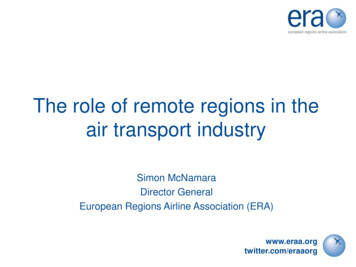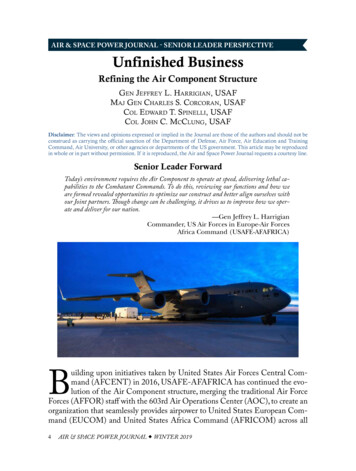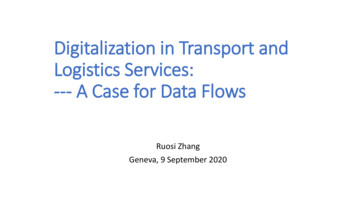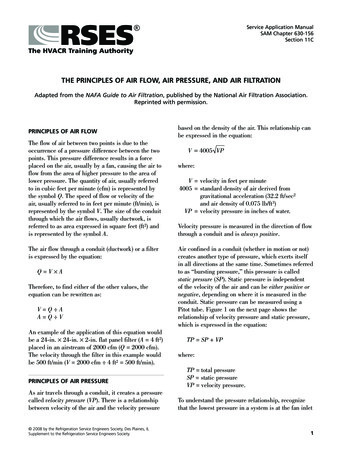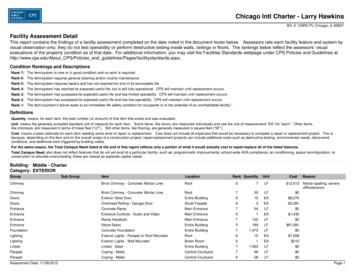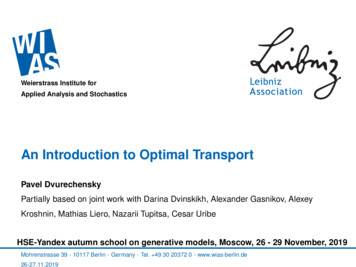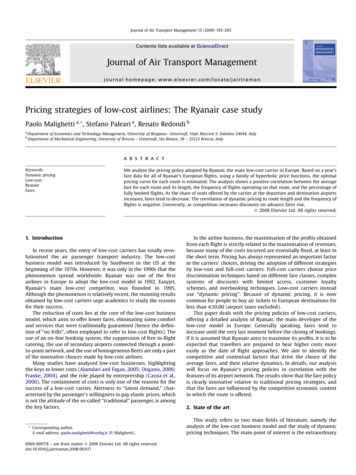
Transcription
Journal of Air Transport Management 15 (2009) 195–203Contents lists available at ScienceDirectJournal of Air Transport Managementjournal homepage: www.elsevier.com/locate/jairtramanPricing strategies of low-cost airlines: The Ryanair case studyPaolo Malighetti a, *, Stefano Paleari a, Renato Redondi babDepartment of Economics and Technology Management, University of Bergamo– Universoft, Viale Marconi 5, Dalmine 24044, ItalyDepartment of Mechanical Engineering, University of Brescia – Universoft, Via Branze, 38 – 25123 Brescia, Italya b s t r a c tKeywords:Dynamic pricingLow-costRyanairFaresWe analyse the pricing policy adopted by Ryanair, the main low-cost carrier in Europe. Based on a year’sfare data for all of Ryanair’s European flights, using a family of hyperbolic price functions, the optimalpricing curve for each route is estimated. The analysis shows a positive correlation between the averagefare for each route and its length, the frequency of flights operating on that route, and the percentage offully booked flights. As the share of seats offered by the carrier at the departure and destination airportsincreases, fares tend to decrease. The correlation of dynamic pricing to route length and the frequency offlights is negative. Conversely, as competition increases discounts on advance fares rise. 2008 Elsevier Ltd. All rights reserved.1. IntroductionIn recent years, the entry of low-cost carriers has totally revolutionised the air passenger transport industry. The low-costbusiness model was introduced by Southwest in the US at thebeginning of the 1970s. However, it was only in the 1990s that thephenomenon spread worldwide. Ryanair was one of the firstairlines in Europe to adopt the low-cost model in 1992. Easyjet,Ryanair’s main low-cost competitor, was founded in 1995.Although the phenomenon is relatively recent, the stunning resultsobtained by low-cost carriers urge academics to study the reasonsfor their success.The reduction of costs lies at the core of the low-cost businessmodel, which aims to offer lower fares, eliminating some comfortand services that were traditionally guaranteed (hence the definition of ‘‘no frills’’, often employed to refer to low-cost flights). Theuse of an on-line booking system, the suppression of free in-flightcatering, the use of secondary airports connected through a pointto-point network, and the use of homogeneous fleets are only a partof the innovative choices made by low-cost airlines.Many studies have analysed low-cost businesses, highlightingthe keys to lower costs (Alamdari and Fagan, 2005; Doganis, 2006;Franke, 2004), and the role played by entreprership (Cassia et al.,2006). The containment of costs is only one of the reasons for thesuccess of a low-cost carrier. Alertness to ‘‘latent demand,’’ characterised by the passenger’s willingness to pay elastic prices, whichis not the attitude of the so-called ‘‘traditional’’ passenger, is amongthe key factors.* Corresponding author.E-mail address: paolo.malighetti@unibg.it (P. Malighetti).0969-6997/ – see front matter 2008 Elsevier Ltd. All rights reserved.doi:10.1016/j.jairtraman.2008.09.017In the airline business, the maximisation of the profits obtainedfrom each flight is strictly related to the maximisation of revenues,because many of the costs incurred are essentially fixed, at least inthe short term. Pricing has always represented an important factorin the carriers’ choices, driving the adoption of different strategiesby low-cost and full-cost carriers. Full-cost carriers choose pricediscrimination techniques based on different fare classes, complexsystems of discounts with limited access, customer loyaltyschemes, and overbooking techniques. Low-cost carriers insteaduse ‘‘dynamic pricing’’. Because of dynamic pricing, it is nowcommon for people to buy air tickets to European destinations forless than V10.00 (airport taxes excluded).This paper deals with the pricing policies of low-cost carriers,offering a detailed analysis of Ryanair, the main developer of thelow-cost model in Europe. Generally speaking, fares tend toincrease until the very last moment before the closing of bookings.If it is assumed that Ryanair aims to maximise its profits, it is to beexpected that travellers are prepared to bear higher costs moreeasily as the date of flight approaches. We aim to identify thecompetitive and contextual factors that drive the choice of theaverage fares, and their relative dynamics. In details, our analysiswill focus on Ryanair’s pricing policies in correlation with thefeatures of its airport network. The results show that the fare policyis clearly innovative relative to traditional pricing strategies, andthat the fares are influenced by the competitive economic contextin which the route is offered.2. State of the artThis study refers to two main fields of literature, namely theanalysis of the low-cost business model and the study of dynamicpricing techniques. The main point of interest is the extraordinary
196P. Malighetti et al. / Journal of Air Transport Management 15 (2009) 195–203performance of the major low-cost carriers, especially whencompared with the trend, and the average profitability, of the airtransport industry in general. Researchers have extensively examined the cost-effective policy, which so clearly permeates the lowcost business model. Franke (2004) and Doganis (2006) havefocused in particular on the cost benefits that low-cost carriers canderive from their operational choices. Their studies show that thereis no single driving element responsible for the competitiveadvantage. Rather, all the choices made contribute to the production of cost benefits. Gudmundsson (2004), using a longitudinalsurvey approach, studies factors explaining the success probabilityof the ‘‘new’’ airlines and finds that productivity and brand imagefocus are significantly related to financial non-distress, whilstmarket power (market-share) focus is significantly related tofinancial distress.A first mover competitive advantage could explain why the mostsuccessful airlines seem to be able to maintain their market leadership in the short and medium term, are the ones that gave rise tothe phenomenon, as witnessed by the likes of Southwest in the USAand by Ryanair and Easyjet in Europe. It is clear that, a good lowcost strategy can never be replicated in all its detailsdand thiscould account for the carriers that succeeded as well as for thosethat did not. Alamdari and Fagan’s (2005) study quantified theimpact of the deviation from the original low-cost business model.The importance of the different strategic choices made bycarriers suggests investigating other elements of the low-costbusiness model. Revenue analysis is an important element that hasbeen less studied. Indeed, the generation of revenues is onedistinctive aspect differentiating low-cost from full-cost airlinespolicies. Piga and Filippi (2002) have analysed the pricing policiesof the low-cost business model in comparison with the pricingstrategies of the full-cost airlines. Coherent choices seem to beessential in pricing policies as well. For instance, the widespreaduse of the Internet for the sale of tickets tends to decrease pricedispersion. This phenomenon may in part be attributed to the‘‘efficiency of electronic markets,’’ as defined by Smith (Smithet al., 2000).The success of the low-cost model is based on a fragile balancebetween fare levels, load factors and operating costs. The structureof revenues and the determination of prices are nearly as importantas the minimisation of costs in the equation of profits. Indeed, anexcellent pricing strategy for perishable assets results in a turnoverincrease, ceteris paribus, which can be quantified between 2% and5%, according to Zhao and Zheng’s (2000) study.The analysis of fare levels and policies aims to understand thekey factors in the achievements of low-cost carriers, including theeffects of the competitive interaction between carriers (Pels andRietveld, 2004). The price choices and the ability of the airlines tounderstand the characteristics of the demand, in either a conditionof monopoly or a competitive context, are decisive in the balance ofthe business model itself. Fare dynamics must be taken intoaccount in a thorough evaluation of market competitiveness, and ofthe benefits travellers have achieved through deregulation.This paper analyses the pricing strategies adopted by Ryanairagainst the characteristics of the context in which it operates,including the degree of competitiveness.First, the study deals with the demand curve derived fromRyanair’s prices. The analysis starts from the microeconomic principles of dynamic pricing. Generally speaking, airlines deal withperishable goods sold in different time steps, with the aim tomaximise profits. The offer of seats on a flight can be compared tothe sale of ‘‘perishable assets’’ with pre-determined capacity inconditions of negligible marginal costs. The themes investigated bythe relevant literature are dynamic pricing and yield management.Zhao and Zheng (2000) have determined the minimumconditions required for optimal dynamic pricing. Because the pricetrend is influenced by demand, one part of the literature focuses onoptimal pricing policies by using specific functional forms torepresent demand and customer benefits. For example, it is quitetypical to use an exponential demand curve (Gallego and VanRyzin, 1994) and a mechanism ‘‘of customer arrival’’ into themarket with a probability similar to a Poisson process. The studiesmentioned above presuppose a continuous optimal price function.Other studies are more likely to hypothesise the existence ofa limited range of prices (Wilson, 1988). The present study adoptsa continuous function, because Ryanair offers a wide range ofprices.The study of price dynamics raises interesting questions. Manytravellers have probably noticed that prices often tend to increaseas the flight date approaches. According to McAfee and te Velde(2006), in the period preceding the flight date, the price trendmainly depends on the trade off between the option of waiting fora potential lower price, and the risk of seats becoming unavailable.In this case, the functional form of the demand curve, together withits adjustment over time, also help to determine a series ofminimum prices.This study analyses the range of actual prices on all of Ryanair’sroutes. It aims to validate some of the assumptions made in theliterature through a thorough study of this wide empirical sample.The estimated demand curve makes it possible to make inferencesabout the trend of bookings and the curve relating to the fullybooked aircraft. Stokey’s (1979) studies determined an optimalconstant filling curve in a context of monopoly. Similar results canbe obtained by using a demand with functional forms belonging tothe family of continuous functions presented by Anjos et al. (2005).For such functions, when dealing with goods that are to be sold bya given deadline, it is possible to define and implement the optimalpricing strategy. The reference curves adopted in this study belongto the Anjos family of curves.The structure of demand, which guides the optimisation choicesof the carrier, is influenced by the presence of competitors, and thepassengers’ opportunities to opt for a substitute service. Classicalstudies, starting from Borenstein’s (1989) analysis, have mainlyfocused on the airlines’ average fare level, showing the undeniableinfluence exercised by the competitive structure on the fares of fullcost airlines. Such competitive structures are exemplified by a farepremium correlated to the dominance of the hub of reference.Alderighi et al. (2004) have pointed out that full-cost airlines tendto decrease fares on routes also operated by low-cost carriers. Theinfluence of the competitive structure on the pricing strategies oflow-cost carriers has been less studied, as far as we know. Pels andRietveld’s (2004) studies have examined the evolution of fares onthe London–Paris route; traditional behavioural models do notseem to apply here, given the mixture of direct and indirectcompetition.It is not clear whether the presence of other airlines can critically affect the pricing strategies of low-cost carriers. Pitfield (2005)has analysed the routes originating from Nottingham East Midlandsairport in 2003, when it was possible to observe low-cost airlines indirect competition. The results showed a weak influence of thecompetitive structure on prices. The historical pattern of faresoffered by each airline seems to play a more important role, aswould be expected in a situation of price leadership. In a studyexamining the London–Berlin and London–Amsterdam routes,Barbot (2005) found that the low-cost and full-cost markets coexiston totally separate levels, so that low-cost carriers compete ‘‘only’’among themselves, as do full-cost carriers.The approach we have adopted here focuses on the differentbehaviours assumed by carriers according to the distinctive characteristics of the routes they operate. We aim to identify thecompetitive and contextual factors that drive the choice of theaverage fares, and their relative dynamics.
P. Malighetti et al. / Journal of Air Transport Management 15 (2009) 195–2033. Methodological aspectsThe literature on low-cost carriers highlights the important roleplayed by dynamic pricing. It is assumed that once the flights havebeen scheduled, the marginal costs incurred in relation to thenumber of passengers are practically null. It follows that themaximisation of profits is strictly dependent on the maximisationof the revenue function. Let the reference unit of time be the singleday.1 Considering T days, the revenue R can be expressed asR ¼TXpi qi(1)i¼1where pi is the flight price on the day i of the year, and qi is thenumber of seats booked on the same day. The optimal pricingstrategy results from the maximisation of the previous expression,under the binding limit of the aircraft’s capacity, which can beexpressed asTXqi Q(2)i¼1where Q is the capacity, that is, the total number of seats availableon the aircraft.For the purposes of this study it is assumed that, for the specificroute and type of customers availing themselves of low-cost flights,the operator is not a price-taker. We hypothesise that thecompetitive structure and the level of market and product differentiation enable the operators to modify the price variable. Themaximisation problem can be solved through a ‘‘lagrangian’’.L ¼TXpi qi þ m Q i¼1TX!(3)qii¼1where m represents the Kuhn–Tucker’s multiplier, which takes intoaccount the aircraft limit of capacity. It follows thatm Q TX!qi¼ 0i¼1If the limit of capacity is reached, m 0; if not, m ¼ 0. In order todetermine the optimal price pi at the specific time i, the derivativeof the expression (3) with respect to pi must equal zero, thusobtainingT vqXvLjpj m¼ qi þ¼ 0vpvpiij¼1where i ½1; K; T (4)This expression can be held valid even if the markets on thedifferent days are not ‘‘separated.’’ In this case, for example, the fareduring one period can modify the quantity of available seats ina successive period, that is, vqj/vpi s 0 with i s j. In line with many ofthe studies analysed in the literature, for the purpose of this study, it isassumed that the markets for the purchase of air tickets are separatedin time, that is vqj/vpi ¼ 0 with i s j. A later development of this studywill eliminate this hypothesis in order to verify the possible interactionbetween the demands of the different periods.Here, expression (4) is simplified in the following optimalconditions:vqqi þ ðpi mÞ i ¼ 0vpi1where i ½1; K; T Demand and prices are assumed to be fixed over the single day.(5)197This study considers the functional form of demand as proposedby Anjos et al. (2005), where the demand for air tickets depends onprice levels, and on the time interval between the purchase dateand the flight date, according toqi ¼ Ae a pi FðiÞwhere i ½1; K; T (6)where A and a are two constants, and F(i) is a function positivelycorrelated to the time period between the purchase date and theflight date. In this case, the function of demand is subject to anexponential decrease as the advance purchasing time increases.An advance booking is less useful because people are less sure oftheir plans far in advance. Given the functional form of the demandin expression (6), it is possible to identify the optimal pricingstrategy by substituting the following form for pi in expression (5).pi ¼ m þ1a FðiÞ(7)The multiplier m can be viewed as the extra charge assigned tothe fully booked flights.2 In the next section, some F(i) forms will betested on Ryanair’s actual prices. The parameters of the pricefunction will be estimated by minimising the quadratic errorcompared to the actual prices. The underlying assumption is thatRyanair operates by maximising its revenues, and using a demandfunction similar to function (6). Therefore, the accuracy that may beobtained using the model for the estimation of prices enablesassessment of the validity of the forms of the demand curves.Through the substitution of the optimal price expression (7) inthe expression (6), we haveqi ¼ Ae 1(8)Expression (8) implies that, following the application of theoptimal price, the expected demand is steady over time. If thequantity sold over a certain time span is greater than the steadyexpected quantity, the operator may decide to raise the price.Similarly, the operator may decide to reduce the price in order togain demand when demand is scarce.In the empirical calculations, two functions are used for theestimation of prices. The first expression ispi ¼ m þ1a ð1 þ b iÞ(9)where i is the number of days between the advance reservation andthe flight date. The form of the optimal price is a hyperbola with theprice going up as the flight date approaches. This functional formmakes it impossible to obtain price reductions as the flight dateapproaches.A more complete functional form ispi ¼ m þ1 pffi a 1 þ b i þ g i2 þ q i(10)In this case, the price may decrease as the departure dateapproaches. The degree of accuracy of both functional forms will bediscussed in the next section.The hypothesis is that Ryanair has tailored a pricing strategy forspecific routes. In other words, it is assumed that Ryanair holdsspecific values for the parameters in (9) and (10) for each individualroute. An estimation of the parameters of the price functions ismade for each route using data from the 90-day period before theflight date.2Fully booked flights have no available seats on the day before departure.
198P. Malighetti et al. / Journal of Air Transport Management 15 (2009) 195–2034. Sample and descriptive analysisTable 1Variation of the network operated by Ryanair between July 2005, and June 2006.4.1. Reference dataVariable7/1/20056/30/2006D%Our database includes the daily fare for each route3 operated byRyanair over the 4 months prior to the flight. The study examinedall the flights scheduled by Ryanair from 1st July, 2005, until 30thJune, 2006. The database enables (1) a comparison between thefares for the different routes, and (2) tracing the fare variation foreach individual route as the flight date approaches.Number of served airportsNumber of daily flights (average)Number of routesPercentage of routeswith daily flight frequencyPercentage of routes withmore than a daily flight frequencyPercentage of routeswith no daily flight .423.6%3.4%6.3%25.8%4.2. Characteristics and evolution of the network operatedby RyanairRyanair’s network is characterised by a very dynamic and steadyexpansion. A comparison between the data gathered as of 1st July,2005, and later on 30th June, 2006, gives a clear picture of thedimensions of the phenomenon: in July, 2005, Ryanair served 95airports, increasing to 111 one year later; over the same period,routes expanded by 34.4%, reaching the total number of 594 (seeTable 1).Nonetheless, 25 routes that were operated in July 2005 werethen cancelled; 6 routes saw their flight frequency halved; and thefrequencies of 16 other routes were each decreased by more than10%. Ryanair operates on many low-frequency routes, 70.8% of theoverall network being made up of routes with only one single flightper day. By and large, it may be said that Ryanair serves its routesdaily. However, in 2005–2006 this trend changed, as the number ofroutes with no guaranteed daily flight increased from 14 to 77.An estimation of Ryanair’s ASK4 (Available Seat Kilometres)distribution is made possible by the information available about thescheduled flights, and the distance between the departure andarrival airports. From a geographical point of view (see Fig. 1),Ryanair’s main business focuses on the connection betweenEngland, Ireland, and the rest of Europe (44.2% of the routes, and49% of the flights start at British or Irish airports). The major flow(measured in ASK) is between Italy and England (14.6%) (see Table 2).Apart from the British Isles, the main flow is between Italy andSpain (3.1% of the whole business). The domestic routes playa relatively small role, accounting for less than 5% of the scheduledair traffic, in terms of numbers of both flights and routes. Italy is theonly place besides the British Isles in which Ryanair operatesdomestic routes.The significant increase in new routes and markets occurred ina surprisingly balanced way. The geographic distribution in 2006 isapproximately the same as in 2005, with only a slight decrease inservice to the UK (Table 3).Ryanair’s network comprises mainly short-length journeys,with all its routes ranging between 200 km and 2000 km and witha median value of 1040 km (as shown in Fig. 2). The distributionproves symmetrical with respect to the median value, forminga bell-shape histogram with the exception of two peak levels at 450and 1800 km.Fig. 3 shows the percentile distribution of ticket prices withrespect to advance booking in days. It is understood that prices mayvary according to other parameters as well, for example, routespecificity. Yet the role played by advance reservation in Ryanair’spricing policy is so significant that average figures also provideimportant information about Ryanair’s pricing strategies. For3At the beginning of July 2005, the total number of routes was 442, while by thebeginning of July, 2006, it had risen to 594. The definition of route is to be intendedhere as directional. Outbound and inbound routes between two airports are thusconsidered as two different routes.4ASK (Available Seat kilometres) accounts for the number of seats available ona flight multiplied by the route’s length (in kilometres).instance, the figures demonstrate that in 75% of cases (75thpercentile in Fig. 3) the price5 does not exceed V50 for bookingsmade at least 20 days earlier than the actual date of flight. On thecontrary, during the last week prior to the flight all prices increasedsharply, with ticket prices exceeding V75 within 3 days of the dateof flight in 50% of the cases, and topping V200 in 5% of the cases.The impression of a steady increase in prices as the date of flightapproaches is verified only on average. As a matter of fact, Ryanairmakes sure to provide ‘‘special offer’’ periods in which fares reachtheir lowest. Such periods do not seem to have any particularrecurrence in terms of length and time. When restricting theanalysis to flights operated on the same route only, it is not possibleto mark a specific period for promotions. Indeed, most routes showa slight increase in prices, or at least a steady upward trend similarto most of the percentiles shown in Fig. 3. Fig. 4 shows the averageprice trend on the Rome Ciampino–London Stansted route (onewith high-frequency service), while Fig. 5 shows the exact price onspecific dates. Fig. 4 compares two price trends pertaining to twodates, neither of which falls on a holiday (such as a bank holiday ora religious festival). No steady price trend can be observed in eithercase: over the 90 days leading to the flight date, lower fares areoffered as the departure day approaches, but this occurs in the twocases during different periods of time, with different lengths andintensities. If it is assumed that this phenomenon may occur oftenin Ryanair’s pricing policy, it may be inferred that the expectationsof the passengers should admit a probability (p) for the price to fallin the following days.Thanks to the database at our disposal, we were able to investigate the recurrence of special offers in Ryanair’s pricing policy. Foreach individual flight we calculated the percentage of days onwhich the price offered was lower than any other previous price.Data were gathered per route, and analysed according to thepattern of distribution of the percentages. Fig. 6 shows the distribution by percentiles on the Rome Ciampino–London Stanstedroute. On this route, 50%6 of the flights monitored (‘50th percentile’in Fig. 6), do not show any downward price trend within 30 days ofthe date of flight. In the case of 30-day advance bookings, 25% ofcases (75th percentile curve) were recorded with at least 6following days on which prices were lower than the one recordedon the day, whilst 2.5% of cases recorded at least 18 days in a rowwith lower prices.The data gathered do not provide information about the actualnumber of seats booked for each single flight. Conclusions onvolumes are drawn in the empirical analysis (Fig. 10). Nevertheless,the data show whether the flights were fully booked in the 24-hperiod before the scheduled departure date. As a matter of fact,Ryanair makes use of a non-refundable ticket policy and no5Unless otherwise stated, the price mentioned throughout this work refers tothe ‘‘net’’ fare indicated on Ryanair’s website, which excludes other cost categoriessuch as airport taxes, security fees and credit/debit card handling fees.6Referred to 691 out of 1382 flights monitored on the route analysed.
P. Malighetti et al. / Journal of Air Transport Management 15 (2009) 195–203199Table 3Distribution of Ryanair’s flights considering their country of origin and theirvariation.Situation as of 1/7/2005Fig. 1. Distribution of Ryanair’s flights and served airports (as of 30th June, 2006).overbooking procedures, which means that when a flight is fullybooked the website shows the unavailability of seats. For eachindividual flight, we calculated the fully booked flight ratio (wherefully booked flights are defined for our purposes as those with noavailable seats in the last 24 h before departure). Fig. 7 shows thedistribution of routes according to the fully booked flights ratio.The same period was monitored for all routes and covered all of themonths considered in the analysis. The figures highlight theunquestionable ability to fill all seats available on the differentroutes, with most of Ryanair’s routes being declared fully booked10–20 times out of 100.5. Empirical analysisIn the empirical analysis, we applied Eq. (9) to estimate the pricetrends for each individual route. The equation was obtained from anexponential demand function subject to Ryanair’s profit maximisation, and showed that, as the date of flight approaches, theprice trend tends to resemble a hyperbola driven by parametersa and b, where a indicates the highest price level that may bereached during the last days before the scheduled departure date.The lower a is, the higher the fare will be the day before departure.Parameter b indicates instead a decrease in the fares that is directlyproportional to the increase in the number of advance booking daysSituation as of 6/30/2006RoutesDaily )820.7100%ATBECZDEDKESFIFRHUIEIE (domestic)ITIT (domestic).LTLVNLNOPLPTSESKUKUK 667187204183(14)Total442650.2100%594before departure. A low b will show a steady price trend as thenumber of advance booking days increases. On the contrary, a highb indicates a significantly discounted fare, with respect to thehighest fare ever offered, on advance purchases. Finally, parameterm shows the average surcharge in the cases of flights characteristically fully booked on the day before the scheduled departure.These parameters were calculated for all routes for which faresdating back to at least three months before the actual date of flightwere available. 550 out of the 594 monitored routes have beentaken into consideration. The remaining routes had been onlyrecently introduced, were monitored for less than three months,and consequently were not taken into account. The parameterestimates were carried out by minimising the standard error of thepredicted fares for each individual route.Table 2Main flows between nations operated by Ryanair (as of 30th June, 2006).RankCountry pairsASK (daily average)%12345678910England - ItalyEngland - SpainEngland - IrelandEngland - FranceEngland - SwedenEngland - PolandEngland - GermanyIreland- SpainItaly - SpainItaly - 014.612.87.36.94.44.03.53.43.13.1Fig. 2. Route distribution according to route length (as of 1st July, 2006).
200P. Malighetti et al. / Journal of Air Transport Management 15 (2009) 195–203Fig. 5. Prices on the Rome Ciampino–London Stansted route for two specific dates.Fig. 3. Fares trend distribution according to advance booking in days.The distributions of parameters a and b are shown in Figs. 8and 9 respectively. The distribution of parameter a shows a higherfrequency of routes with parameter a levels around 0.008–0.01,with a maximum average price higher than V100. Par
airlines in Europe to adopt the low-cost model in 1992. Easyjet, Ryanair's main low-cost competitor, was founded in 1995. . the relevant literature are dynamic pricing and yield management. Zhao and Zheng (2000) have determined the minimum conditions required for optimal dynamic pricing. Because the price



